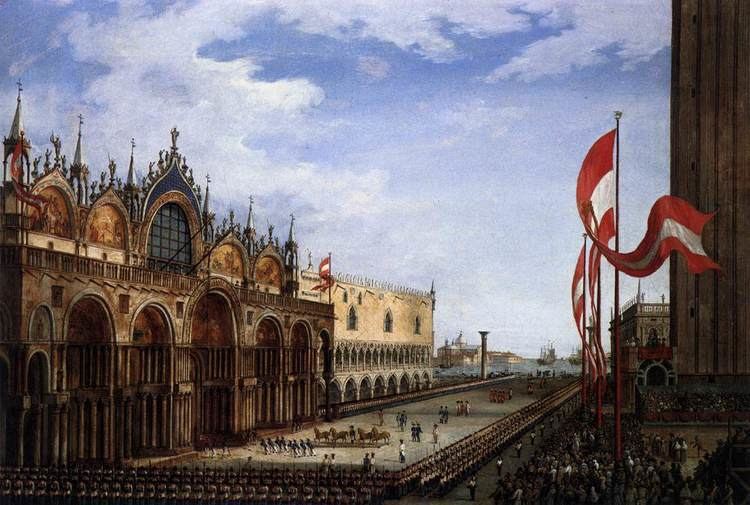Name Vincenzo Chilone | Died 1839 | |
 | ||
Vincenzo Chilone (10 July 1758, Venice,Italy - 12 January 1839, Venice,Italy) was an Italian painter who specialized in vedute, after the style of Canaletto.
Biography
He was born in the neighborhood of the parish of San Samuele, Venice. In writing a biography of his friend, the professor of architecture in the Venetian Academy of Fine Arts, Francesco Lazzari, obtained an autobiographical recount from the painter, where he describes his parents as poor. His father, Andrea, was originally from Greece and his mother from Mirano. By age ten, Chilone was first apprenticed to a weaver of silk stockings, then to a wood carver. Soon after, he came to live with Sante Boselo and his elder brother, both painters. Chilone then became a pupil of the Modenese perspective painter Francesco Battaglioli. From there he came in the studio of Alessandro Mauro, where he aided in some large historical canvases.
Economic needs and family misfortunes led him to become an assistant to Mauro, a theater architect, and set designer. All of his work was done without credit. After Mauro's death, he tried briefly to work on his own but eventually accepted a position in Udine. He collaborated with another Mauro - Antonio, to do the frescoes at a theater that were originally decorated by the painter Giambattista Canal, whose eyesight was failing. He remained in Udine for some time and helped decorate the Palazzo Marcotti.
On June 25, 1781, he married Francesca Cavisago and ultimately had 17 children. Seeking more income and independent success, he traveled in 1795 to Udine with the painter Mauro Antonio. But by 1797, the turmoil of the Napoleonic wars had slackened commissions.
He returned to Venice in 1815, virtually forgotten, and was forced to work for other painters. Most of his canvases were sold cheaply to middle-men, some of whom made a huge profit by passing them off as works by Canaletto. Perhaps in response to this, he began to display more stylistic autonomy. Soon, he enjoyed the patronage of the nobility. In 1824, he was elected a member of the Accademia di Belle Arti di Venezia. That same year, he received a major commission from the expatriate Venetian musician, Domenico Dragonetti, who was also an art collector and dealer.
After the death of his first wife in 1824, he remarried in Venice and in 1825 was elected as academic of perspective painters to Royal Academy of Fine Arts of Venice. In August 1834 some of his paintings, including a view of Venice representative of the Palazzo Pesaro with other factories, were bought to King William IV, then four veduta of Venice were bought by the king of Prussia during a trip to Venice. While his income improved, he mused in a retrospective autobiographical entry that though his career briefly improves:
I was condemned by fortune for not putting into practice the present customs, that is to say the deceitful back-biting, and the mask that everyday triumphs over all, but for a man of good understanding, honest and fair, there is no power that is worth dressing for in the above-mentioned modern costumes, and mutate his nature. It is better to die dying than by those "vituperous means" gorge himself.
He painted a Church of Santa Maria from the Ponte de Rialto In 1830 collaborated in designs for Giacomo Alipandri in prints of vedute. These vedute include:
Spaking of his works at an exhibition in Venice, the contemporary art critic Lampato commented:
In Chilone we are astonished by the ageless perseverance with which the painter recalls his fleeting youth. Chilone is the Antellus of painting, and comes to the race for glory with his present merits augmented by his past trials. In him, it is properly said that art is life. By that one means that he paints what he lives. He paints the sites of our city worthy of memory; where the houses of the illustrious dead are found, as well of the houses of the illustrious that are going to arise and for which there has not until now been the intention. He desires to depict not only the historic but also the facts...calm and serenity reign, together with other qualities, to allow his paintings to give us a beautiful portrait of his soul.
Despite having this degree of success, he apparently died in poverty in Venice.
